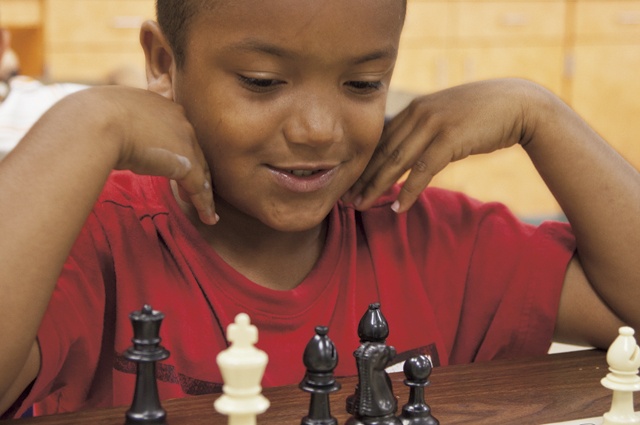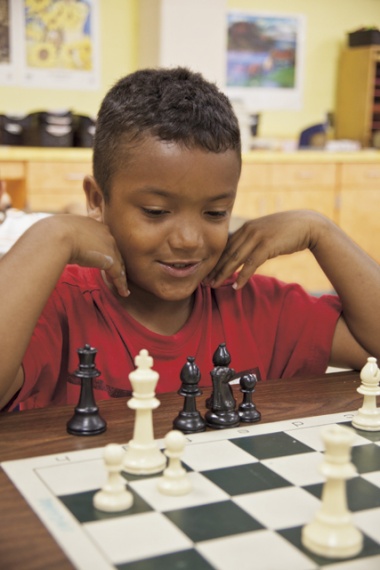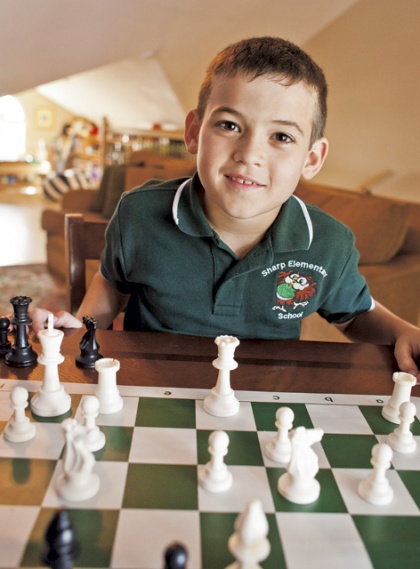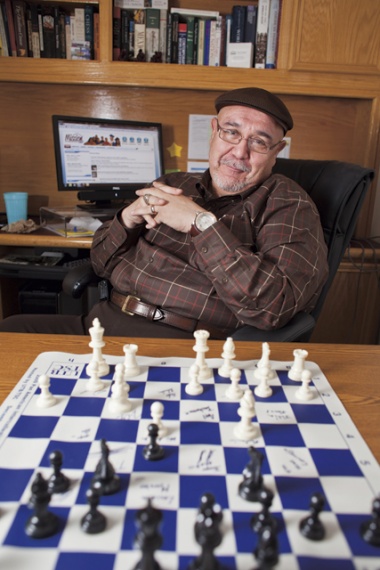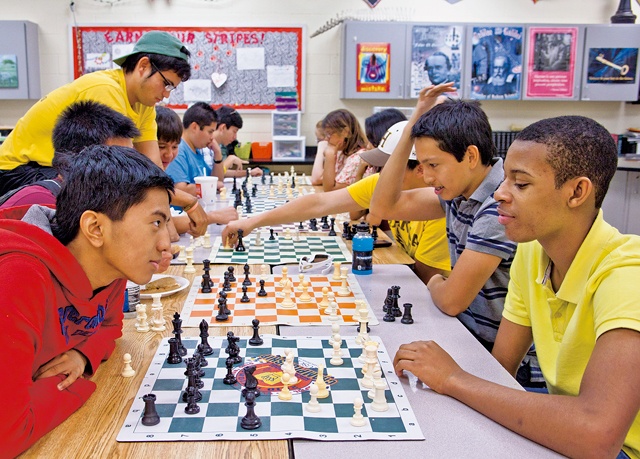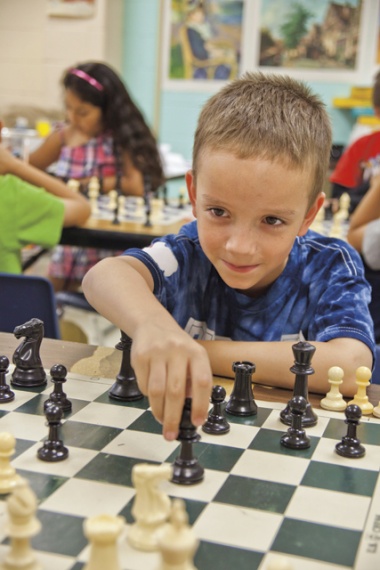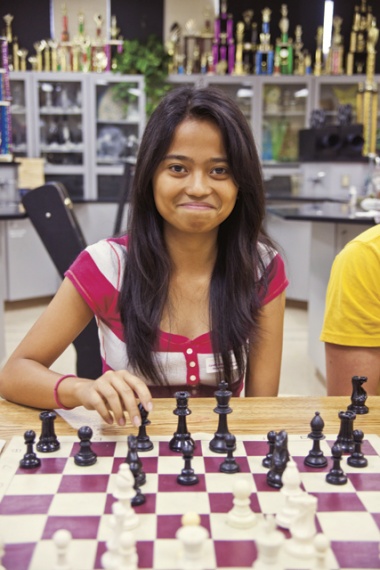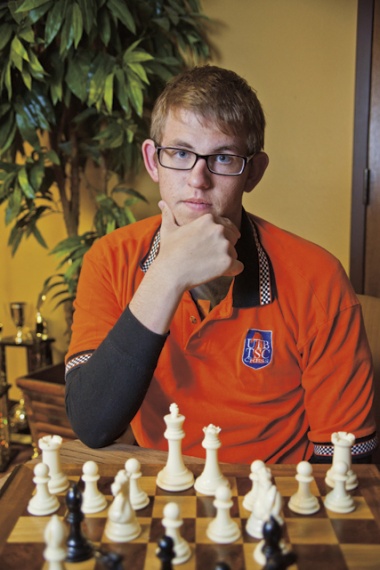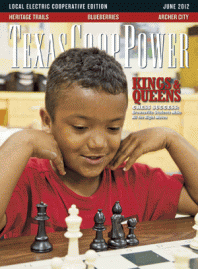With foldable chessboards in small, oblong bags slung over their shoulders, armies of excited children squeeze through the halls of Filemon B. Vela Middle School on a winter Saturday morning. Everywhere, coaches, teachers and volunteers shuffle groups back and forth from one corridor to the next to gaming areas set up throughout the small campus in Brownsville. Alongside follow mothers and fathers, cousins and grandparents, aunts, uncles and anyone else the competitors’ families have invited to the annual Chess of Champions, one of 10 major chess tournaments held for students in kindergarten through high school in this border city.
Brownsville, with a population exceeding 175,000, sprawls along the southernmost tip of Texas in the Rio Grande Valley. The lush city with tropical temperatures and palm-fringed, artificial lakes, known locally as resacas, attracts avid bird-watchers from around the world and serves as a winter home for thousands of retirees—typically from the Midwest and the North—dubbed Winter Texans or “snowbirds.”
But the city lies in an impoverished area, where the median household income is roughly $30,000, about 95 percent of students are considered economically disadvantaged and 34 percent have limited proficiency in English. When Brownsville and other cities in the Valley make national headlines, it is usually in connection with the politics of immigration or the atrocities of the drug war only a stone’s throw away in Mexico.
Yet, over the past two decades, a different story has attracted the attention of major media outlets, including Texas Monthly, The New York Times, CBS and HBO, as they chronicle the legacy of chess as a phenomenon in the region and the burgeoning of some of the world’s newest young talent.
At national championships, schools from the Brownsville Independent School District have placed among the top five in team competition since 2005. At the state level, they have dominated the Texas Scholastic Championships chess competition, winning about a dozen first-place slots at the elementary, middle and high school levels since 1993.
Tournaments like the one at Vela Middle School are family affairs. Parents, relatives and community members pitch in to raise money, contribute team snacks and meals—be it breakfast tacos or lasagna—and pack schools during competitions, so much so that in some instances, police have even been called out to unsnarl traffic jams.
At Vela, the parking lot is filled to the brink, and cars spill onto the side streets, parked brazenly under “No Parking” signs. Inside the gym, the commotion amplifies. Players search for their places among rosters taped to the walls and press their way through rows and rows of numbered, brown cafeteria tables. Hundreds of chessboards, checkered forest green and white, deck their surfaces, pieces at the ready: rooks biding time to topple kings, queens waiting to capture knights.
Gertrude Sharp Elementary School second-grader Eduardo Campella Rodriguez, or “Campy” as his friends call him, climbs onto his assigned metal chair. He sits on his knees to get a full view of the chessboard in front of him. The pint-sized 8-year-old with bright, chestnut eyes and a quick wit isn’t nervous, he says. Not yet. So far, he has always won his first round. “Maybe by the fourth or fifth I will be, but I get more confident when I win,” he later says with a sheepish smile.
He is good at winning, too. He beams when his teachers list his victories. He placed second in his division at his first national chess tournament. He was 5 then, and in kindergarten. But Campy’s triumph for such a young child does not surprise most Valley educators or chess coaches. There is no mystery—and more to it than luck—behind what has led to the rise of young chess stars like Campy.
It’s due to hard, hard work. It’s due to community effort. “To me, it comes down to expectations,” says Juliet V. Garcia, president of the University of Texas at Brownsville. Children from the Valley, predominantly Hispanic, are often clumped into stereotypes and assigned government labels, such as at-risk or low-income. But when it comes to the game of chess, educators and parents impel them to succeed—and they thrive.
“It’s a pretty powerful change of a paradigm,” she says.
Chess: What the Cool Kids Play
J.J. Guajardo has told this story at least 600 times to friends, family members and dozens of reporters, he estimates, chuckling. But he does not mind sharing it again. It is inspirational, he says, one of the few positive tales told about Brownsville, where the good is often overlooked or forgotten.
School officials and parents consider Guajardo the father of the city’s chess movement. He’s a figure they revere along the lines of Jaime Escalante, a Los Angeles high school teacher whose mentoring of at-risk students turned a failing calculus program into one of the nation’s best. The true story played out in the 1988 film “Stand and Deliver.”
But Guajardo, a soft-spoken, large man with kind eyes, is more modest. On a warm November night, sporting a Hawaiian shirt and a brown, tweed flat cap, he sits with his wife at a small pub in McAllen, a large Valley city about an hour from Brownsville. He is honored by the Hollywood comparisons, he says, but prefers the focus stay on the students. “I don’t think I picked chess,” Guajardo says. “Chess picked me.”
He was a teacher at Brownsville’s Russell Elementary School in 1989 when several children in his rambunctious group of sixth-graders were believed to have broken the gym coach’s vinyl square dance records as part of a prank. No outright accusations were made, Guajardo recalls, but the episode brought the principal marching into his classroom.
The principal urged him to create an extracurricular program that could keep the group of high-energy students busy in the mornings and stop them from causing trouble. She suggested chess.
Chess. The art form—or sport (it is often debated which)—is known as the “royal game,” in which the pieces, kings and queens, bishops and pawns, are moved across a checkered board to attack and capture. Its history spans centuries, a pastime popular among the echelons of the elite who have mastered the skills of strategy and analytical thought.
And Guajardo was charged with introducing all of this to a group of children who could barely keep still. But his students showed an interest, and he taught them how to play, even though he only knew the basics. All of the children built upon the foundations Guajardo taught them, and later, they could win in a match against their instructor.
The students raised about $500 (Guajardo paid most of it out of his own pocket) to attend their first state championship in Austin in the spring of 1990, he recalls with a proud smile. They did not win that year. But they did win two school years later—and every time after that for the next seven consecutive years.
Like the students, Guajardo improved with practice and started organizing competitions at the school. “I started learning the nuances of the game and how to run a tournament, how to read a wall chart, how to make sure the pairings were correct, and we began to become more sophisticated as we participated,” he remembers.
The chess team at Russell Elementary also gained participants, growing from a dozen students to more than 50 after the team won its first school title. Soon the school’s competitions were drawing hundreds. Students from across the country wanted to travel to Brownsville for a chance to compete against Russell players, and newspapers throughout the region began featuring its hometown heroes, Guajardo says. Chess became what the cool kids did.
Kings and Queens on Campus
Guajardo resigned as Russell Elementary’s chess coach in 1999, but the movement he spurred continued forward. More schools in the Brownsville school district and private schools across the area developed chess programs.
In 1999, Morningside Elementary School gripped media attention when a group of second- and third-graders placed second in the national championships. It was the first time a school from Brownsville had made it that far.
“And it really just took off. We started with six kids, and by the time we left Morningside, we had well over 100 kids playing chess,” says Rusty Harwood, one of three second-grade teachers at the time who, inspired by Guajardo’s success, started the chess team. Harwood, who now serves as the director for the chess program at The University of Texas at Brownsville, went on to teach at Americo Paredes Elementary in 2001. There, he helped start another chess team that advanced to win seven national titles through the years, including six under his direction.
The community rallied behind the students’ successes, and the chess movement grew into a citywide effort, with students and faculty working with families and local businesses to raise funds for tournaments and trips. For many children who had never left Brownsville, traveling to state and national competitions allowed them to explore other parts of the country for the first time. Parents later banded together to gain financial support from Brownsville ISD. Now, the program operates on an annual budget of $400,000.
As the program soared, UTB President Garcia was among its major proponents. While on a visit to Washington, D.C., to serve as chair of the Advisory Committee to Congress on Financial Aid, she told then-U.S. Secretary of Education Richard Riley about Morningside Elementary’s 1999 feat. It became the first example of success cited by Riley in his speech titled “State of the Union Address for Hispanic Education.”
And when a former college student approached her with the idea of launching a chess program at UTB, Garcia says she did not have to think about it twice. “It felt absolutely natural,” she says of drawing upon an existing pool of students who were quickly surpassing the levels of their instructors and seeking a higher platform to which to advance.
When the UTB chess team formed, one of its loftiest ambitions was beating The University of Texas at Dallas, known for its success at the national level. Now the college students are going head-to-head with Ivy League students from Harvard and Yale: UTB teams have advanced three times to Final Four competition—the country’s topmost collegiate tournament sanctioned by the United States Chess Federation—and have placed in the top five four times at the Pan American Intercollegiate Team Chess Championships, the foremost intercollegiate team chess competition in the Americas.
Better training at the university level also has since trickled down to younger students, school officials say. The area had no grandmasters, the highest title a player can attain in chess, back in the 1990s when Guajardo’s students first started taking state titles. Now, the UTB chess team, including its coach, boasts four of roughly 1,250 grandmasters in the world.
Future Moves
School officials say they do not see enthusiasm for the game ever fizzling out in Brownsville. With university players now serving as coaches, and with former Brownsville ISD students returning to teach, younger students are developing increasingly higher skills.
Chess competitors in the Valley now span the ages. Most train in free, afterschool lessons held three to four times a week. Before violence escalated in Mexico, some families crossed over into Matamoros, only a few minutes’ trip across one of the city’s three international bridges, where they could pay less for coaching than on the U.S. side. There are still some brave enough to try, like the family of 12-year-old Edgar Santoyo, who was featured on HBO’s Real Sports. But most stick to private tutors and computer programs designed to increase proficiency, school officials say.
Many outsiders are amazed upon learning that Brownsville students are so good at chess. Back in the day, Guajardo remembers, intimidated opponents would spread rumors that students practiced instead of going to class—of course, that was not true, he assures. School leaders have more realistic theories; bilingual students, for instance, could have an edge when learning chess because it is a lot like learning another language.
To Garcia, the most important piece, she says, is that educators need to do a better job of tapping into students’ potential. “The discussion is not really about chess, is it?” she asks. “It’s about how the brain really works and how expectations work and how then, why aren’t we able to translate the success children are having in chess into other disciplines?”
Yet some educators have seen chess help students in other areas. It boosts self-confidence and develops high critical-thinking and memory skills, school officials say, requiring players to recognize and memorize elaborate patterns of attack. Teachers and coaches attest to students’ improvements in academics as well, noting higher state standardized testing scores.
And chess also teaches students life lessons, Guajardo says. “One of the basic rules of the game is ‘touch move,’” he explains. “That means that if you touch a piece, you have to move that piece. You can’t take it back.”
You can’t say, “Never mind.” So the children sit on their hands, until they absolutely know what their next move will be and can commit to it. They learn the virtue of patience and to calculate, to predict outcomes, to be self-sufficient. “They learn how to succeed using their own wit, without anyone’s help,” Guajardo says. “Because in chess, you are all alone out there.”
Across the street from Vela Middle School sits Cameron Park, a colonia, or humble neighborhood, considered one of the most impoverished areas in the nation.
But the disparities and struggles of the outside world seem far removed from the classroom where several children have their chessboards laid out on the floor, enthralled in last-minute practice sessions before their next match.
——————–
Jazmine Ulloa is a reporter for the Austin American-Statesman.
